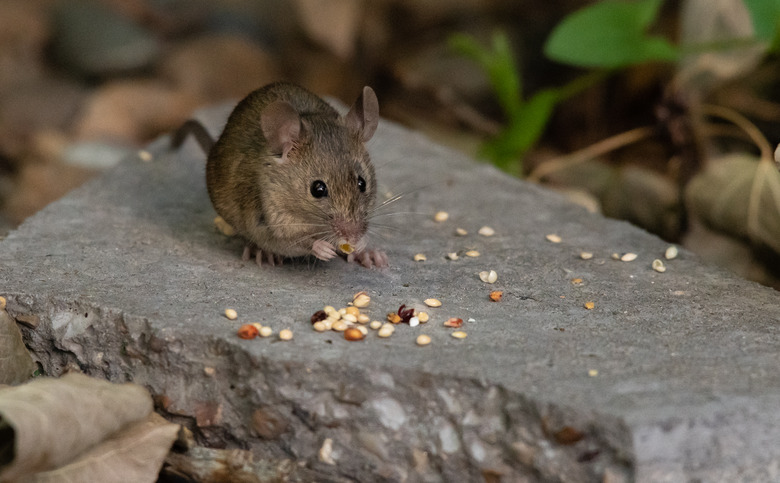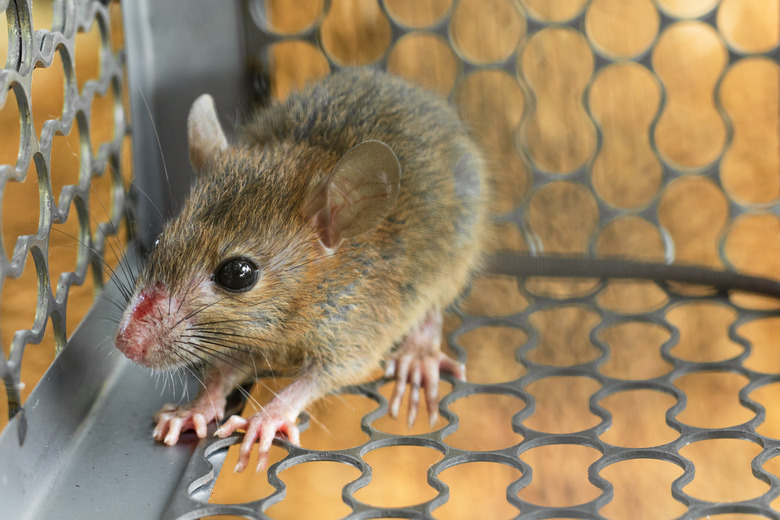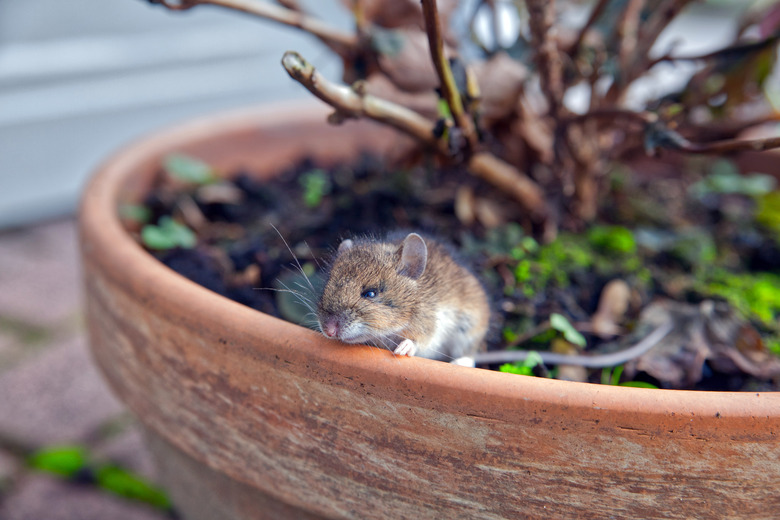How To Get Rid Of Mice
We may receive a commission on purchases made from links.
If you spot a mouse skittering through your home or tiny black feces leading up to a crack in your wall, you need to act quickly to get rid of the mice that have invaded your home. Even though these creatures may be cute, they can destroy your property by chewing holes in all types of surfaces, and tracking in dangerous bacteria and viruses. To make matters worse, they're prolific breeders, so the longer you wait to get rid of mice in your home, the worse your infestation will get. Luckily, there are many reliable methods for eliminating mice, from humane live traps to classic and reliable snap traps.
What Do Mice Look Like?
What Do Mice Look Like?
- Species name: House mouse (Mus musculus)
- Physical characteristics: Mice have large ears and a slender body around 3 inches long. Their tail is
typically as long as the rest of the body. Generally, house mice are gray or
brown in color with a white belly.
- Color/species varieties: There are 38 mouse
species, though the house mouse is the most common species found in homes.
They come in many colors, including white, tan, and black. Their bodies range from 2 to 5 inches long. - How to tell mice apart from rats: Mice and rats may both be rodents, but they are quite different.
Rats are dramatically larger than mice and are usually around 9 inches long, though
they can grow up to 15 inches long. Mice have smaller ears and more narrow
snouts. Feces can clue you in to whether you have a rat or mouse infestation. Rat droppings are around 1/2 inch long, and mice feces are half as long and look
like dark grains of uncooked rice.
How to Get Rid of Mice
How to Get Rid of Mice
There are two basic ways to get rid of mice: traps and poisons. Whatever method you use, remember to clean up well after the mice have been eradicated since their urine and feces are health hazards.
Snap Traps
When it comes to mouse traps, no trap is as iconic as the wooden snap trap, although there are plenty of plastic alternatives as well. These spring-loaded traps quickly trigger and snap down on mice, killing them instantly (most of the time).
Electric Traps
Electric mouse traps are large boxes that attract mice with bait and then instantly electrocute them after they enter the box. After use, a light turns on to let you know the trap needs to be emptied and reset.
Glue Traps
These sticky boards leave mice to get stuck in a thick layer of glue until they starve. They do not need to be baited but simply placed in areas frequented by mice so they can walk over them. In fact, baiting these can actually make the glue less effective.
Mouse Poisons
The only safe and legal poison to use in the home is bait that is completely enclosed inside a bait station. Loose rodenticides, such as pellets, are prohibited by Environmental Protection Agency for the consumer market, although you can still find such products for sale. Loose baits pose a serious risk to pets and children and should not be used in or around the home. Rodenticides in bait stations are designed to be carried back to a mouse's nest and hopefully shared with others.
Foods Toxic to Mice
Do you not like the idea of having toxic poisons in your home because you have children or pets? Try sprinkling foods that naturally kill mice along the paths they frequent. Powdered mashed potatoes expand in a mouse's stomach until the stomach lining rips open. Alternatively, make a mixture of equal parts flour, sugar, and baking soda since baking soda gives mice gas, and they can't expel it, so the stomach will rupture.
Household Pets
Cats are the oldest mouse control method in the world. Many cats love to hunt and kill mice, sometimes just for fun. Some pups may do the same. This is an eco-friendly option, but it's not a good idea to adopt an animal solely as a form of pest control.
Use a Variety of Mouse Traps
The basic wooden snap trap is still the best mouse trap out there, but for best results, use a few different trap types because mice sometimes avoid certain traps but will still fall victim to others. Place more traps than you think you need because people almost always underestimate the severity of their mouse infestation. For a medium-size infestation, consider getting an electric trap or two, a dozen wooden snap traps, and at least six plastic snap traps to cover your bases.
Use Multiple Types of Bait
Aside from using a variety of traps, try multiple types of bait since you don't know what will appeal most to a given mouse. While peanut butter is the most common bait, also try chocolate, nuts, bacon, oatmeal, birdseed, or even nesting materials, like cotton balls, yarn, or feathers. To ensure a mouse doesn't make off with the bait without triggering the trap, try to secure the bait to the trap with fishing line or dental floss if possible. Finally, to keep bait appealing, change out fresh foods every two days.
Place Traps in Specific Locations
Put some thought into the best place to put your traps as well. Set them in the back of cabinets, next to trash cans, and behind your refrigerator. Also place a trap every foot or so perpendicularly along your walls with the trigger facing the baseboards so they're right in the line of the mouse's natural path of travel. This will eliminate the risk of the mouse triggering the trap prematurely by approaching it on the wrong side. Relocate traps every few days to keep them interesting to curious mice.
Seal Off Entry Points
When you have mice in your home, it's also important to seal off their access to your home to prevent new mice from getting inside. The best way to do this is to look for trails of mouse droppings. They will typically lead you to the mouse's entry points, which could be as small as a pencil eraser.
Seal small cracks and gaps with caulk. For larger holes, fill the open space with steel wool before covering up the hole to discourage mice from chewing their way back in. Also install door stops under all exterior doors and weatherstripping around outside doors and windows. Once you've addressed gaps and cracks on the inside of your home, block off entry from the outside of the home as well. Look for penetrations through exterior walls, such holes for pipes, wiring, and vents, as well as gaps around siding and door and window trim.
Identifying Hidden Nests
If mice are in your home, they may be nesting in uninhabited spaces, such as a crawl space, attic, basement, or garage or even inside the walls themselves. This is why it is so important to look for droppings to identify where mice are hiding in your home. When the nests are in hard-to-reach areas, like a crawl space or inside your walls, it is particularly important to avoid using poison since it may be difficult or even impossible to reach a dead mouse body, and you do not want to smell rotting mouse in your home for the next few months. Instead, place traps in areas where they are entering your home so you can easily catch and dispose of the mice.
When to Hire a Pro
When to Hire a Pro
Most mouse infestations can easily be handled by homeowners, but if you have a major infestation or if your DIY approach isn't proving effective, call in a professional exterminator. Start by asking friends and neighbors for pest control recommendations, and if you want to handle things in a humane way, look for companies that specialize in live traps.
Only hire a pest control company licensed by the state (if your state offers pest control licenses) and ask if the company is a member of any state or national associations, since this can indicate that it is up to date on the latest pest control techniques. Expect professional mouse control to cost between $200 and $600 depending on the severity of your infestation.
Getting Rid of Mice Naturally
Getting
Rid of Mice Naturally
To get rid of a mouse infestation without killing the pests, start by cleaning and mouseproofing your house so they won't have easy access to the inside. While many people turn to ultrasonic pest repellents, research indicates that these aren't particularly effective on rats or any other pests.
Using scents as a mouse repellent, like essential oils, can be effective. More specifically, apply clove, cinnamon, or peppermint oil to cotton balls and place them in areas where mice frequent. Alternatively, sprinkle spices that mice hate, such as cayenne pepper, cinnamon, red pepper flakes, or garlic powder. This won't rid you of an infestation, but it will make your house less appealing to the critters.
Next, invest in some live traps, bait them, place them in areas with high mouse activity, and check them every morning. For live traps to be effective, you must release the mice at least a mile away from your home (and away from other people's homes). Wear sturdy gloves and do not touch the mice directly. Keep in mind that you'll likely need to keep trapping mice for weeks or even months in order to fully eliminate an infestation.
How Quickly Can You Get Rid of Mice?
How Quickly Can You Get Rid of Mice?
Traps are the most effective way to eliminate mouse infestations, but the amount of time it takes to eliminate an infestation will vary based on the number of mice involved. Expect the process to take anywhere from a few days to a whole month depending on whether you have a small or large infestation.
How Mice Get In Your House
How Mice Get In Your House
Mice can enter homes through any gap or crack in your walls or beside your windows as well as under your doors. They can squeeze through a space as big as 1/4 inch wide and may even chew through walls or wiring to get inside your home.
While mice may enter your home at any time of year, they are most likely to invade during fall and winter months, when they search for food, warmth, and shelter. Unfortunately, they breed all year long and can have up to 10 litters in a year, with each litter containing between four and 11 babies. All in all, just two mice can have 110 offspring in one year. Acting quickly is key in controlling a mouse infestation.
How to Prevent Mice
How to Prevent Mice
To keep mice out of your home, you should keep a clean house, try to discourage them from hanging out in your yard, and seal any potential entry points they can use to get inside. With minimal reasons to enter your house and no easy way to get in, mice are likely to leave your home alone.
When it comes to cleaning your house, look specifically for things that would provide food, water, or bedding for mice. Store all food in the refrigerator, freezer, or airtight containers made from glass, metal, or thick plastic. Wipe all eating and cooking surfaces, like the stove and countertops, at the end of the day and wash your dishes immediately after use. Sweep and vacuum food crumbs that fall on the floor or furniture. Take out the trash every night and use lockable garbage cans.
Whether outside, in a garage, or in the house, discard clutter that mice may use for nesting material, such as old newspapers, boxes, or magazines. Store pet food in a sealed container and clean up food bowls after their meals. It's also smart to not leave pet food or water containers outside overnight.
Keeping mice out of your yard can also reduce the likelihood that they will get inside your home. Hang bird feeders away from your home and install squirrel guards on them. Be sure to clean outdoor cooking areas after use. It's also a good idea to keep woodpiles and compost bins over 100 feet away from your house.
Selective gardening may also help, including growing mouse-repellent plants. Cut back shrubs and branches so they do not touch your house and keep grass near your home short.
Do Mice Cause Damage or Spread Disease?
Do Mice Cause Damage or Spread Disease?
Mice can cause significant damage to your home and present serious dangers to your health. They chew through drywall and wood, leaving holes, bite marks, and claw marks in your walls, baseboards, and door frames. Since mice also tend to chew on wires, they can short circuit your appliances or lights.
These pests are also dangerous to humans. Contact with mice, mouse mites, or dust that contains mouse urine or droppings may expose you to hantavirus pulmonary syndrome, lymphocytic choriomeningitis, leptospirosis, salmonellosis, typhoid, and more. After disposing of mice, be sure to clean up after them using a diluted bleach spray on droppings and urine before wiping or mopping the area. Wear a face mask while cleaning up dead mice, urine, or droppings. Always wash your hands after handling dead mice or anything they have touched.
References
- Popular Science: How to Get Rid of Mice
- HomeAdvisor: How Much Does Rodent Control Cost?
- The Strategist: Everything You Need to Prevent and Get Rid Of Mice, According to Exterminators
- Kitchen Fun With My 3 Sons: 6 Clever Ways to Get Rid of Mice That Actually Work
- Britannica: Mouse
- Rentokil: Differences Between Rats & Mice
- Home Depot: How to Get Rid of Mice
- Terminex: The 8 Best Ways to Help Get Rid of Mice




